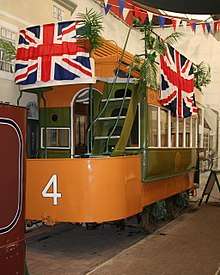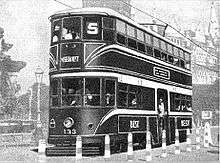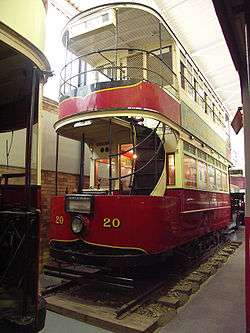Double-decker tram


A double-decker tram is a tram that has two levels. Some double-decker trams have open tops. Double-deck trams were once popular in some European cities, like Berlin and London, throughout the British Empire countries in the early half of the 20th century including Auckland, Christchurch and Wellington in New Zealand; Hobart, Tasmania in Australia and in parts of Asia. They are still in service in Hong Kong, Alexandria, Dubai, Oranjestad and Blackpool.
The earliest double-deck trams were horse drawn. The first electric double-deck trams were those built for the Blackpool Tramway in 1885, where Conduit tramcar No. 4 is the sole survivor of its class and is preserved at the National Tramway Museum in Crich, UK. They were common in the United Kingdom until the 1950s. London Transport was a heavy user of double-deck trams until the system closed in 1952. Apart from the Blackpool tramway, the Glasgow Corporation Tramways was the last urban British tramway to close, in 1962. Several tramcars have been preserved at the UK's National Tramway Museum, Beamish Museum, Black Country Living Museum, East Anglia Transport Museum, Heaton Park Tramway, Seaton Tramway, Summerlee Museum and the Wirral Transport Museum. Some have been preserved at New Zealand's Ferrymead Museum in Christchurch and MOTAT Museum in Auckland, which operates restored Wellington double-deck tramcar, No. 47, which operated in 1906[1] and also has Auckland double-deck tramcar, No. 17, in storage. The last double-deck tram built in the UK was Blackpool "Jubilee" Class No. 762, which entered service in 1982. However, it was originally built in 1935 as Blackpool "Balloon" Class No. 251, later renumbered No. 714. Its rebuild as No. 762 gave it a longer body and its pointed ends were replaced with rectangular ones. It was the second and final rebuild of two Blackpool "Balloon" tramcars into "Jubilee" tramcars, following on from "Jubilee" Class No. 761. Unlike No. 761, "Jubilee" tramcar No. 762 retained its central doors as exits for improved passenger flow at stops. For these reasons, it was considered to be an entirely new tram and on this basis, when it was retired in 2011, it was gifted to the National Tramway Museum in Crich.
From 1910 to 1964 double-deck trams were in use in Mumbai, India (Brihanmumbai Electric Supply and Transport Undertaking). They were also in use in Johannesburg, South Africa, where trams were operational from 1906 to 1961. A few of the tramcars in Alexandria, Egypt, are double-deckers.
Double Deck tramcars were used by the Pittsburgh Railways ( streetcar / interurban) between 1913 and 1924, a rare use of such tramcars in the United States of America.[2]
Manufacturers
- Blackpool Tramway - Standard tramcars and rebuilt English Electric tramcars
- Brush Engineering Falcon Works
- Dick, Kerr & Co.
- English Electric and United Electric Car
- Glasgow Corporation Tramways
- Hong Kong Tramways
- Rouse, Black and Son, Wellington, New Zealand
Gallery
 Blackpool Conduit tramcar No. 4
Blackpool Conduit tramcar No. 4- Glasgow Cunarder tramcar No. 1392
 Bombay (Mumbai) tramcar No. 133
Bombay (Mumbai) tramcar No. 133 Johannesburg tramcar No. 20
Johannesburg tramcar No. 20
See also
References
- ↑ "Archived copy". Archived from the original on 2018-02-13. Retrieved 2018-02-12.
- ↑ "Transit In The Triangle, Vol I - 1900-1964", Toman & Hays, c.2012. From page 214
External links
